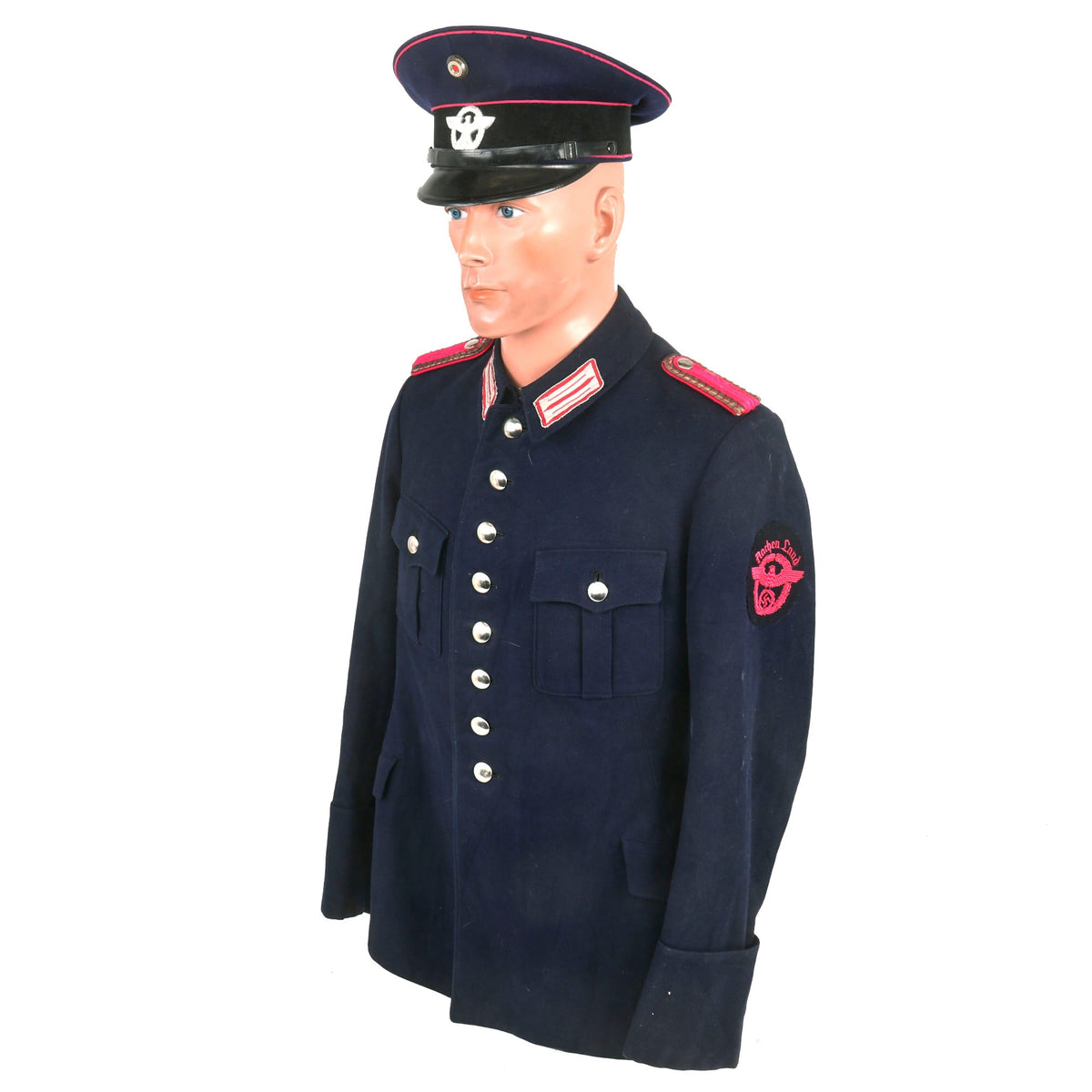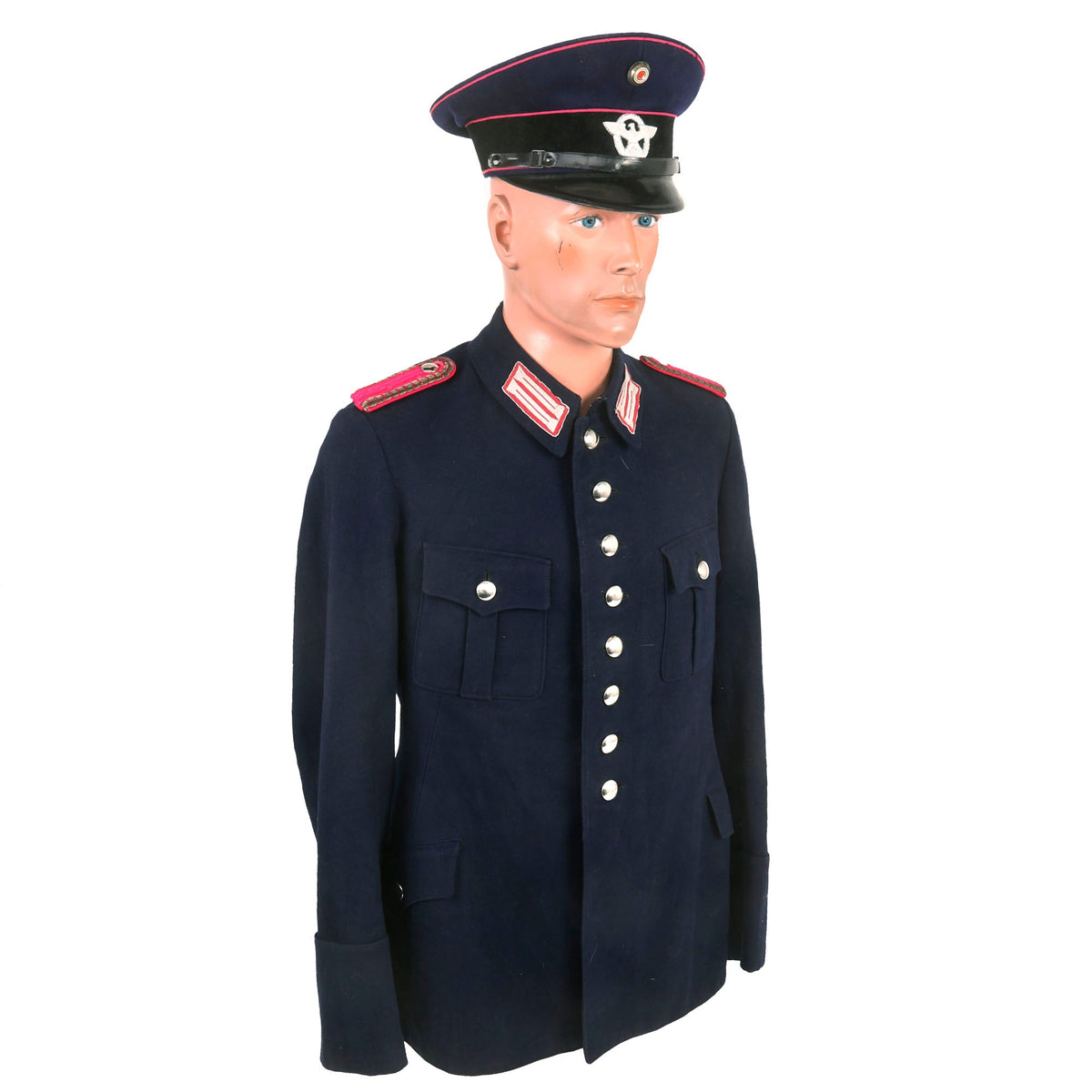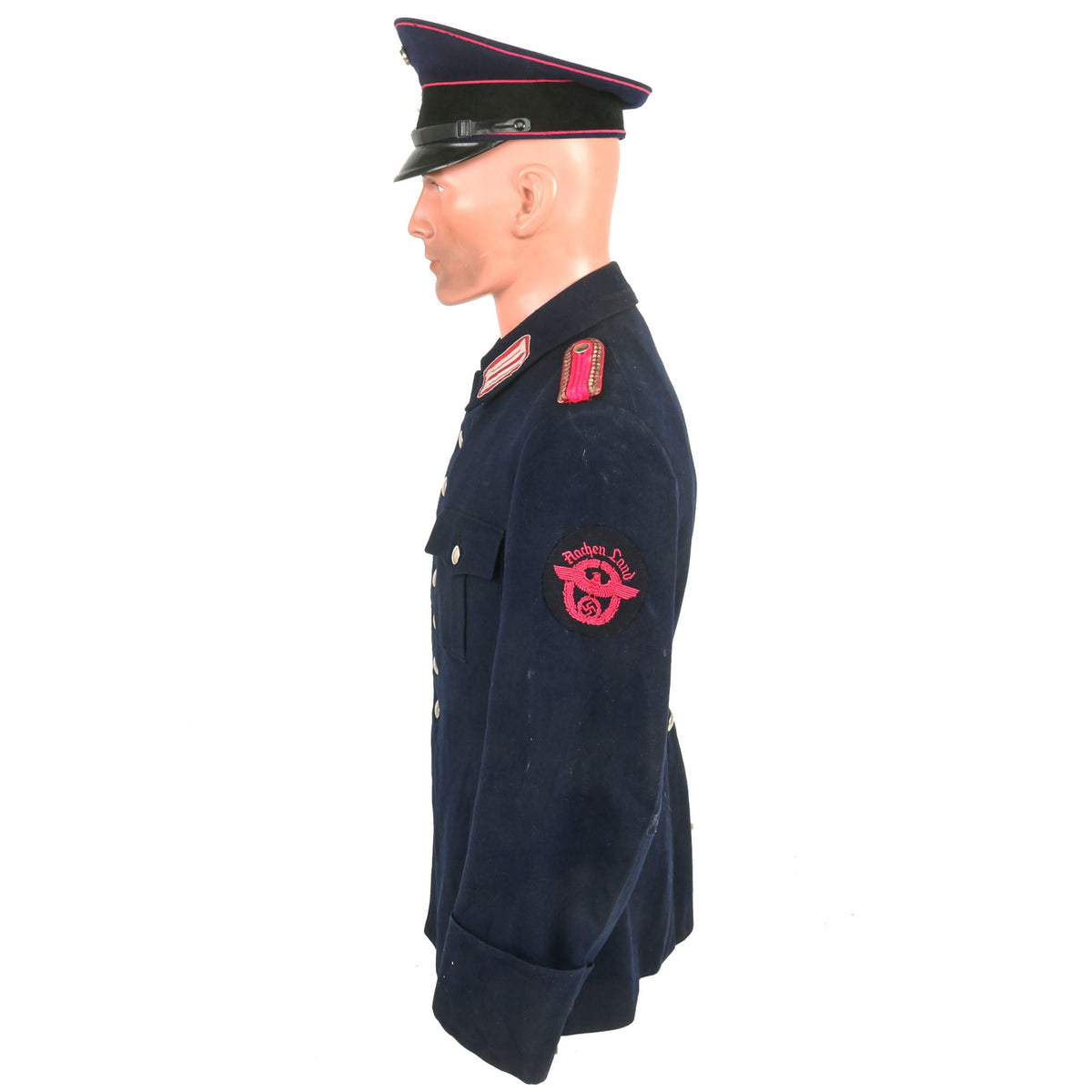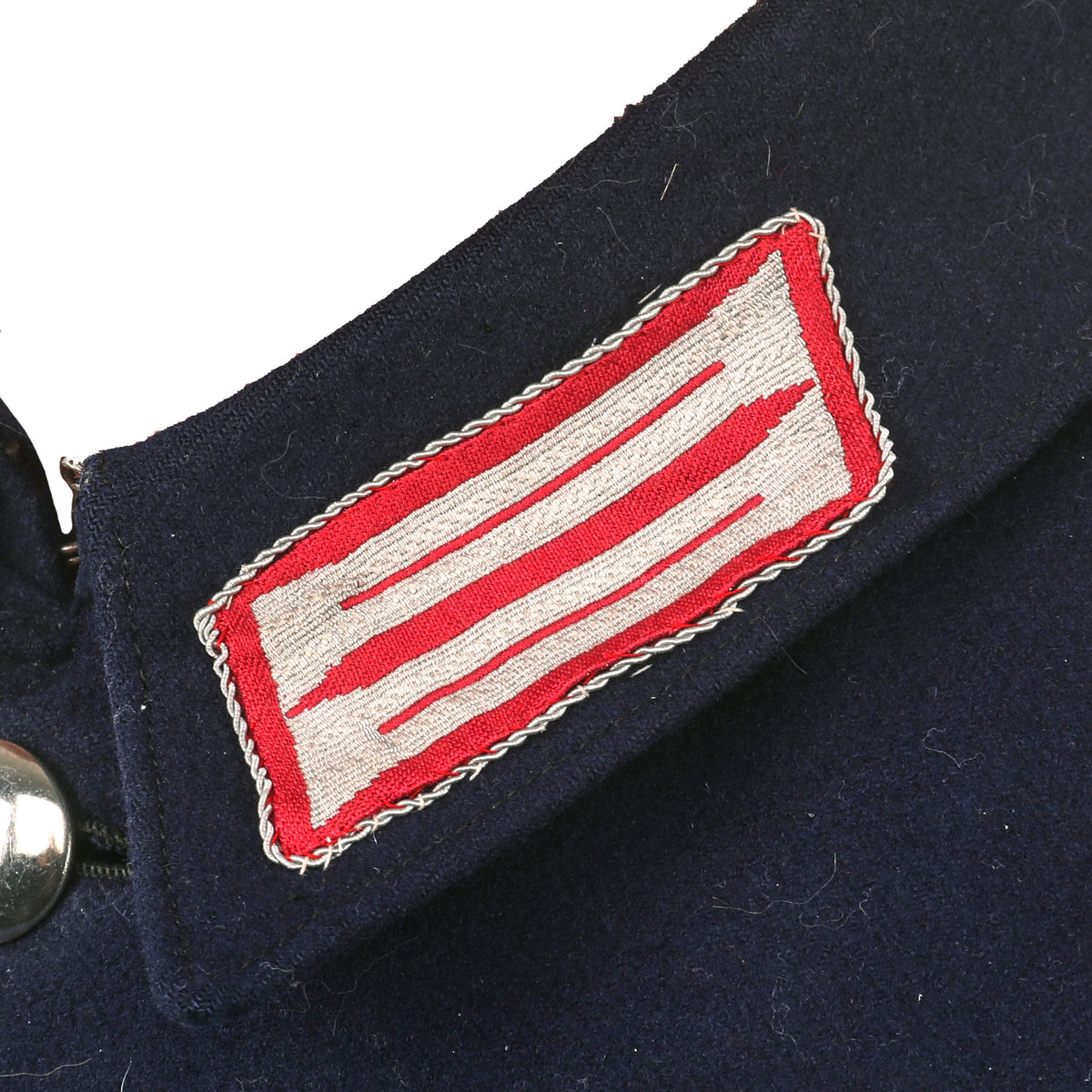Original German WWII Feuerschutzpolizei Fire Protection Police Wachtmeister NCO’s M36 Uniform Tunic and Named 57cm Visor Cap Original Items
$ 725,00 $ 217,50
Original Item: Only One Available. On June 17TH 1936, Reichsführer-SS Heinrich Himmler was appointed to the newly created position of Chef der Deutschen Polizei im Reichsministerium des Innern (Chief of the German Police in the National Ministry of the Interior), effectively giving him full control of all police agencies within Germany including the Feuerschutzpolizei, (Fire Protection Police). As a result of this appointment and the restructuring of all the separate German state police into a single national police force, new regulations were instituted on June 25th 1936 to bring about uniformity in dress for all police through-out the country.
The Police were divided into eight assorted branches of service with each branch being assigned a specific identifying, Truppenfarbe, (branch of service color), with the Feuerschutzpolizei being allocated Karminrot (carmine red) truppenfarbe, which is close in color to magenta. The Feuerschutzpolizei were further distinguished from the other police branches of service with blue uniforms and headgear instead of the typical police green uniforms.
The German Police had no enlisted ranks, with the lowest rank being an Unterwachtmeister (Junior Watch Master), which was equivalent to the German army rank of Unteroffizier. The highest NCO rank was that of the Meister (Master), or Warrant Officer, which did not have an armed forces equivalent, but was higher than an army Oberfeldwebel (Master Sergeant).
This is a lovely example of a rare Feuerschutzpolizei Fire Protection Police Wachtmeister NCO’s M-36 tunic, made of fine quality navy blue “doeskin” style weave wool. In form these tunics are more or less identical to the Army Heer tunic except for the colors and material used. They may also have some additional ornamentation when compared to the standard Army issue. The tunic features two pleated breast pockets with scalloped flaps over two waist slash pockets, which also feature scalloped flaps. These are secured with shiny nickel plated magnetic buttons, and the tunic has an eight button front closure, with “hook and loop” fasteners for the collar, one of which is missing. The rear of the tunic features an overlapping rear vent with ornamental buttons. The buttons on the tunic are sewn directly to the fabric, not attached with metal circlips, and all are in great shape. They all look to have RZM markings stamped onto the back.
The interior is lined with lovely black rayon or brushed cotton, with lightweight white striped cotton lining the sleeves. There is a horizontal slash pocket on the inner left chest, however there are no markings inside or anywhere else on the interior There is just a bit of wear on the interior, with no tears or other damage that we can see.
The collar is wrapped with wool matching the outer shell, has police NCO’s litzen collar patches on each side, which are machine woven from silver bullion thread with a Karminrot (carmine red) background, the Truppenfarbe (Troop Color) of the Feuerschutzpolizei. The collar is in very good shape, showing showing light wear on the top edge. This is first place on the uniform to show wear. As this is a Police tunic, there is no Wehrmachtadler breast eagle, and instead the uniform has a high quality machine embroidered Civic Police Eagle badge machine sewn to the left sleeve. The insignia is sewn using the same carmine red color thread. Above the insignia is the district marking of Aachen Land, which is in the far west of Germany. This means it was made before November 1941, when the district markings on police insignia were removed.
The button-attached style NCO schulterklappen (shoulder boards) of this tunic are bordered with a single row of of fine silver flatware “Russia Braid” double piping around the edge, with carmine red chevrons woven into the design. Inside this is a row of carmine red double piping, and they have the same color base and bottom strap. As the outer row of braid is open on the end, these are shoulder boards for the police rank of Wachtmeister (Watch master), equivalent to an SS-Unterscharführer or U.S. Army Sergeant. Overall condition is very good, with most of the wear visible on the insignia, which are more delicate than the rest of the uniform.
The included visor cap is the correct Feuerschutzpolizei, (Fire Protection Police) NCO/EM Schirmmütze Visor Cap, which is in very good lightly used condition. The cap has a very nice condition brown lightweight canvas lining, which has a fully intact celluloid sweat shield diamond on the top. Under this is a maker logo and the maker name:
Heinr. Gutenberger
Simmern / Hunsrück
The name tag slot also has a very nice paper label, giving the name and location of the owner:
Josef Kemmer 57-
Riegenroth
It features a genuine leather sweatband, marked DEUTCHES LEDER (German leather) on the surface. Condition of the cap is very good, with all parts completely correct.
A lovely German WWII Fire Protection Police Wachtmeister tunic and visor cap, ready to research and display!
Approximate Measurements:
Collar to shoulder: 9″
Shoulder to sleeve: 23”
Shoulder to shoulder: 15.5”
Chest width: 18″
Waist width: 17″
Hip width: 19″
Front length: 30″
Field Tunic (Feldbluse) Model 1936
Terms such as M40 and M43 were never designated by the Wehrmacht, but are names given to the different versions of the Model 1936 field tunic by modern collectors, to discern between variations, as the M36 was steadily simplified and tweaked due to production time problems and combat experience.
When the NSDAP came to power in early 1933 the Reichswehr, the armed forces of the Weimar Republic, were near the end of a two-year project to redesign the Army Feldbluse (field-blouse). Beginning in that year the new tunic was issued to the Reichsheer and then the rapidly growing Wehrmacht Heer, although minor design changes continued to be made until the appearance of the standardized Heeres Dienstanzug Modell 1936. The M36 tunic still retained the traditional Imperial and Reichswehr uniform color of grey-green “field gray” (feldgrau) wool, but incorporated four front patch pockets with scalloped flaps and pleats (on Reichswehr tunics the lower pockets were internal and angled). The front was closed with five buttons rather than the previous eight, and the collar and shoulder straps were of a dark bottle-green instead of the Reichswehr grey. Compared to the Weimar-era uniforms the skirt of the feldbluse was shorter and the tailoring was more form-fitting due to Germany’s adoption of mechanized warfare: soldiers now spent much time in the confined space of a vehicle and a shorter jacket was less likely to pick up dirt from the seats. It also included an internal suspension system, whereby a soldier could hang an equipment belt on a series of hooks outside of the tunic. These hooks were connected to two straps inside the lining, which spread the weight of equipment without having to use external equipment suspenders. The M36 was produced and issued until the very end of the war, though successive patterns became predominant.
SS field uniforms were of similar appearance externally but to fit their larger patches had a wider, feldgrau collar, and the lower pockets were of an angled slash type similar to the black or grey SS service-dress. The second button of an SS Feldbluse was positioned somewhat lower, so that it could be worn open-collar with a necktie. Due to supply problems the SS were often issued army uniforms.
Fast Shipping with Professional Packaging
Thanks to our longstanding association with UPS FedEx DHL, and other major international carriers, we are able to provide a range of shipping options. Our warehouse staff is expertly trained and will wrap your products according to our exact and precise specifications. Prior to shipping, your goods will be thoroughly examined and securely secured. We ship to thousands clients each day across multiple countries. This shows how we're dedicated to be the largest retailer on the internet. Warehouses and distribution centres can be located throughout Europe as well as the USA.
Note: Orders with more than one item will be assigned a processing date depending on the item.
Before shipping before shipping, we'll conduct a thorough inspection of the items you have ordered. Today, the majority of orders will be delivered within 48 hours. The delivery time will be between 3-7 days.
Returns
The stock is dynamic and we cannot completely manage it because multiple stakeholders are involved, including our factory and warehouse. So the actual stock may alter at any time. It's possible that you may not receive your order once the order has been made.
Our policy is valid for a period of 30 days. If you don't receive the product within 30 days, we are not able to issue a refund or an exchange.
You can only return an item if it is unused and in the same state as the day you received it. You must have the item in its original packaging.
Related products
Uncategorized
Uncategorized
Uncategorized
Uncategorized
Angolan Rebel 1970s era 60mm Inert Display Mortar from Angolan Civil War Original Items
Uncategorized
Uncategorized
Uncategorized
Uncategorized
Uncategorized
Uncategorized
Uncategorized
Uncategorized
Uncategorized
Uncategorized
Uncategorized
Uncategorized
Uncategorized
Uncategorized
Uncategorized













































































